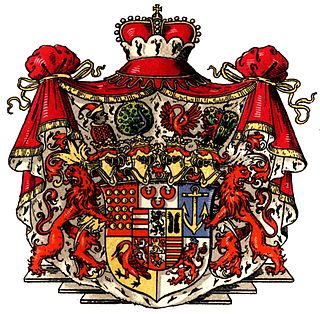Bentheim-Bentheim was a county in southeastern Lower Saxony, Germany. By 1806, the borders were the modern borders of the District of Bentheim. The last Count of Bentheim-Bentheim died on 19 February 1803.

Bentheim-Tecklenburg-Rheda was a historical county of the Holy Roman Empire, located in present northwestern North Rhine-Westphalia and southwestern Lower Saxony, Germany.

Bentheim-Tecklenburg was a German county, later principality, based in the region around Tecklenburg in northern North Rhine-Westphalia, Germany.

The County of Bentheim was a state of the Holy Roman Empire, located in the south-west corner of today's Lower Saxony, Germany. The county's borders corresponded largely to those of the modern administrative district of Grafschaft Bentheim.

The County of Tecklenburg was a state of the Holy Roman Empire, located in the present German state of North Rhine-Westphalia and Lower Saxony.

Louis I of Anhalt-Köthen, was a German prince of the House of Ascania and ruler of the unified principality of Anhalt. From 1603, he was ruler of the principality of Anhalt-Köthen. He was also a founder of the first German Society.

Tecklenburg Castle, or simply the Tecklenburg, is a ruined castle and venue for the Tecklenburg Open-Air Theatre in the eponymous town of Tecklenburg in the county of Steinfurt in the state of North Rhine-Westphalia, Germany. It was once the seat of the rulers of the County of Tecklenburg.

Frederick of Anhalt-Harzgerode, was a German prince of the House of Ascania and the first ruler of the principality of Anhalt-Harzgerode.
Alexius Frederick, Prince of Bentheim and Steinfurt was a German nobleman.

Countess Palatine Dorothea of Simmern was a Countess Palatine of Simmern by birth and Princess of Anhalt-Dessau by marriage.

Arnold III of Bentheim-Tecklenburg-Steinfurt-Limburg was a German nobleman. He was Count of Bentheim, Tecklenburg and Steinfurt, and jure uxoris Count of Limburg. He ruled as Arnold IV in Bentheim and Tecklenburg, and as Arnold II in Steinfurt. In Limburg, he was the first Count named Arnold and hence just the name distinctive.
Magdalena of Neuenahr-Alpen was a German noblewoman. She was the heiress of the House of Neuenahr-Alpen; she inherited the County of Limburg. By marriage, she was Countess of Tecklenburg.

Eberwin III, Count of Bentheim-Steinfurt was a German nobleman. He was a member of the elder line of the House of Bentheim-Steinfurt and was the ruling Count of Bentheim and Steinfurt from 1544 until his death. From 1557, he was also Count of Tecklenburg and Lord of Rheda by marriage.

Anna, Princess of Anhalt-Bernburg was the consort of Christian I, Prince of Anhalt-Bernburg.
Anna von Tecklenburg-Schwerin (1532-1582) was the ruling suo jure Countess of Tecklenburg and the lordships of Wevelinghoven and Rheda between 1557 and 1582. She was regent of the County of Bentheim-Steinfurt during the minority of her son in 1562–1573.

The House of Bentheim is one of the oldest extant German noble families. They are a mediatized family, formerly being rulers of their own territories directly under the Holy Roman Emperor. They belong to both the ancient nobility (Uradel) and the high nobility (Hochadel). Today, there are two main lines of the family: the princes of Bentheim-Steinfurt and the princes of Bentheim-Tecklenburg. There is also a third, non-princely line of the family, the counts of Bentheim-Tecklenburg-Rheda.

The County of Steinfurt, originally the Lordship of Steinfurt, was a historic territory of the Holy Roman Empire in the Münsterland. It existed from roughly 1100 until 1806.
















